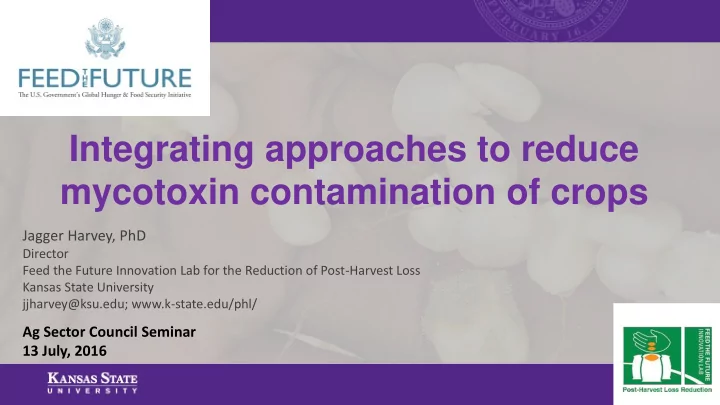

Integrating approaches to reduce mycotoxin contamination of crops Jagger Harvey, PhD Director Feed the Future Innovation Lab for the Reduction of Post-Harvest Loss Kansas State University jjharvey@ksu.edu; www.k-state.edu/phl/ Ag Sector Council Seminar 13 July, 2016
Mycotoxins • Compounds produced by a range of fungi, toxic to human health • Contaminate crops broadly • Carry over into animal-sourced foods Photo: Karanja, KALRO
Aflatoxin • Produced by Aspergillus fungi • Infect a range of crops • Invisible/difficult to detect or sort • Toxic to humans and animals (livestock) – Carcinogenic – Associated with • Stunting • Immunosuppression • Blocking nutrient absorption
2010 outbreak: Eastern Kenya posho mill maize survey 39% >LL aflatoxin (up to 60% by district) 37% >LL fumonisin Samuel Mutiga (Rebecca Nelson, Cornell) Mutiga et al., 2014 Phytopathology 104(11): 1221-1231 (Cornell/UMd/BecA-ILRI Hub)
Aflatoxin risk: a complex set of drivers Aflatoxin risk determined by: Host: crop species and variety/type x Fungal population x Crop management in field x Environmental conditions x Postharvest practices
A broad and expanding threat
A broad and expanding threat
Addressing a complex problem To reduce aflatoxins for all farmers and consumers, reducing risk and addressing contamination along the value chain is essential. Targeting appropriate interventions: Prevention – reduce risk from field to consumption Surveillance and response – when conditions have eclipsed interventions’ effective range
Integrating interventions Preharvest: Biocontrol: competitive exclusion Good agricultural practices: adoption incentive includes higher yield • Reduce biotic and abiotic crop stress (e.g., drought, nutrient stress) • Use appropriate varieties for agroecologies • Planting time • Intercropping, crop rotation, tillage, fertilizer • Planting less susceptible crops Periharvest: harvest time, avoid soil contact Postharvest: adoption incentive includes reduce losses • Testing decontamination and alternative uses • Proper drying Moisture content (measurement) • Proper storage • Testing decontamination and alternative uses (Surveillance to predict hotspots near harvest time: modelling and mobile diagnostics - appropriate sampling)
Post-harvest losses • Losses in quantity and quality, including economic losses. • Estimated ~1/3 loss in developing countries • Scant evidence base – weak methodologies • Many interventions available, off the shelf or used elsewhere • Limited focus on gender – key for development • Limited success and impact to date relative to • Tremendous promise to address food security
FtF Innovation Lab: Post-Harvest Loss Technical focus areas: -drying -storage -insect pests, mycotoxins Cross-cutting: -capacity building (universities, government; lab, curriculum, extension, … ) -nutrition -gender
FtF Innovation Lab: Post-Harvest Loss Afghanistan Tree nuts, Bangladesh raisins, wheat Rice Guatemala Ethiopia Ghana Maize Chickpea, maize, Maize sesame, wheat
Integrating approaches Success 1: novel/adapted drying technologies Success 2: adapted storage technologies Success 3: low cost moisture meter Additional considerations: e.g., Pathway to impact (actors, …), Women’s Empowerment in Agriculture Index
Integrating approaches: Bangladesh USDA-ARS PHLIL Moisture Meter STR Dryer Improved (vs. traditional) storage
Integrating approaches: Ghana USDA-ARS PHLIL Moisture Meter Adapted storage technologies Solar biomass hybrid dryer
The road ahead
Towards integration of mycotoxin reduction strategies
Critical gaps – addressing mycotoxins • Good quality baseline information • In country technical capacity • Standardized sampling and testing procedures • Surveillance tools: mobile diagnostics, modelling and mapping • Alternative uses, decontamination • Understanding the full scope of health risks
Towards an integrated approach • Empowering and working in coordination with national partners • Assessing a baseline along with potential interventions • Appropriate interventions (context, cost, gender considerations, …)
Towards an integrated approach • Involve private sector and regulators co-regulation? • Importance of risk communication • Given geographic, biological, environmental and socioeconomic complexity, have a range of interventions available
Acknowledgements Feed the Future – USAID PHLIL team members (full set of partners at www.k-state.edu/phl/) Afghanistan: John Leslie (Kansas State University) and collaborators, Ministry of Agriculture, Irrigation and Livestock Bangladesh: Prasanta Kalita (University of Illinois at Urbana-Champaign; Director, ADM Institute for Post-Harvest Loss), Monjurul Alam (Bangladesh Agriculture University) and collaborators Ethiopia: Subramanyam Bhadriraju (Kansas State University) and collaborators Ghana: George Opit (Oklahoma State University) and collaborators Guatemala: Carlos Campabadal (Kansas State University) and collaborators Moisture meter: Paul Armstrong, USDA-ARS, Kansas State University Ahmed Kablan Ag Sector Council Seminars
Recommend
More recommend